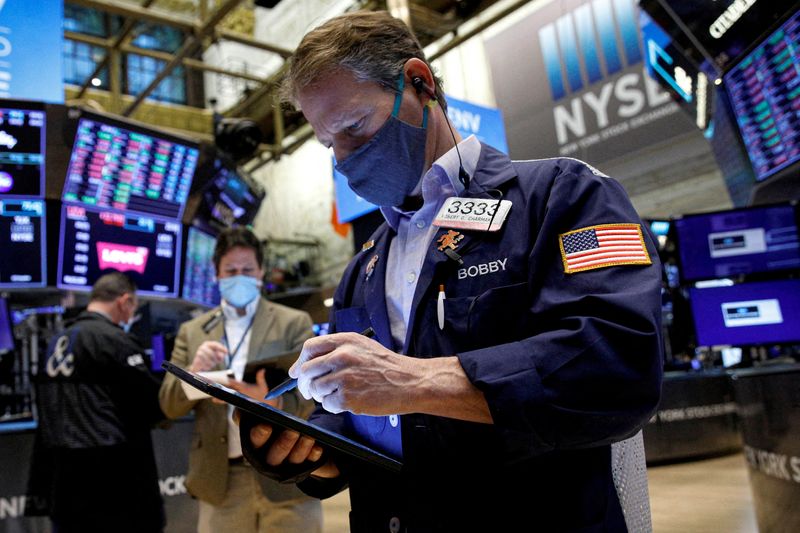By Sujata Rao and Danilo Masoni
LONDON (Reuters) - This month's sudden spike in inflation-adjusted bond yields has jolted TINA, the thesis that "there is no alternative" to stocks, yet if history is any guide, equities should withstand this rise in real interest rates or even flourish.
With inflation-adjusted U.S. 10-year bond yields below minus 1%, many investors have viewed equities as the only mainstream asset capable of providing strong returns.
TINA is believed to be the driver behind the almost $1 trillion inflow into global equity funds last year, a figure that according to BofA data surpassed the combined inflows of the preceding two decades.
Now though, with U.S. inflation peaking around 7% and the Federal Reserve likely to raise interest rates 3-4 times this year, real yields - the nominal interest rate a bond pays minus the rate of inflation - are on the move.
Stocks tumbled after a spike in U.S. yields. The impact was especially severe on the tech-heavy Nasdaq 100 index where stocks trade on the premise of bumper future earnings growth, making them particularly vulnerable to higher interest rates.
The Nasdaq is set for its second worst start to a year since the 2008 crisis, coinciding with a 40 basis point jump in ten-year inflation adjusted yields since Dec. 30.
But banks including JPMorgan (NYSE:JPM) and Goldman Sachs (NYSE:GS) are still advising clients to buy the dip, arguing that real yields remain deeply negative around -0.8%, higher interest rates are already priced in and company earnings are in robust shape.
Above all, equities have performed well during many previous episodes of rising real yields, provided economic growth held up. Bernstein notes for instance that during five past real rate "normalisation" cycles in 1975, 1980, 2012-2013, 2016 and 2020-2021, global stocks returned between 2.3% and 51.8%.
"Historically when real yields have normalised back towards zero from negative levels, equities have had positive returns," Bernstein strategists Sarah McCarthy and Mark Diver told clients.
Separately, data from Truist Advisory Services shows the S&P 500 enjoyed positive returns in 11 of 12 real rate rise cycles since the 1950s.
Real yields moreover should move higher at a more gradual pace and won't hurt markets or economic activity until they actually turn positive, JPMorgan said, predicting year-end levels around -0.25%.
In the meantime, the trend should spur further sector switching - higher real yields tend to be bad news for tech shares but financials, commodities and cyclical shares such as travel usually benefit, JPMorgan wrote.
For a related graphic on US inflation notes, click https://fingfx.thomsonreuters.com/gfx/mkt/akpezendwvr/US%20inflation%20notes.JPG
JAM TOMORROW
Behind the tech selloff is a premise that higher interest rates will cut into lofty share valuations. As a general rule of thumb, a sustained 100 bps rise in the U.S. TIPS yield causes a 20% drop in the price/earnings multiple, Pictet chief strategist Luca Paolini said.
Ultra-low rates have boosted equity valuations globally but those of tech stocks, often viewed as "long-duration" assets negatively correlated to rising bond yields, have ballooned to what some consider bubble territory.
Investing in tech firms, some of which have little or no profit, is therefore a bet on their future earnings potential. When rates rise, the present value of the investment diminishes on fund managers' spreadsheets.
The Nasdaq 100 currently trades at 27.8 times its 12-month forward earnings - a 54% premium over the MSCI All Country World Index, according to Refinitiv Datastream, and almost twice the 10-year average.
Grace Peters, EMEA head of investment strategy at JPMorgan Private Bank, expects the S&P 500 - also tech heavy and currently trading at 21.1 times forward earnings - to end the year with an average P/E ratio a full percentage point lower.
"With expectations that real yields will move up, must come an expectation that equity valuations move down. Multiple compressions will be particularly harsh for the kinds of stocks that are seen as 'jam tomorrow', she said referring to companies that trade off expectations of future profits.
Tangible profits and cash flow rather than future growth would command higher premia as the Fed's rate lift-off approaches, she added.
For a related graphic on Nasdaq 100 valuation premium, click https://fingfx.thomsonreuters.com/gfx/mkt/jnpwejlndpw/Nasdaq%20100%20premium.PNG
RETAIL AND TECH
The other unknown is how retail investors, a major new force in stock trading, will behave as yields rise, and tech turns volatile.
Having become accustomed to buying into stock market dips in the belief that monetary stimulus would staunch selloffs, the retail crowd may find such strategies less rewarding as the Fed prepares the decks for its first rate rise in three years.

Giuseppe Sersale, fund manager and strategist at Anthilia is expecting stock markets to gradually lose momentum - "bounces will get more troubled and the declines more aggressive".
"Retail is currently suffering from fatigue and it doesn't have the firepower it used to have," he added.